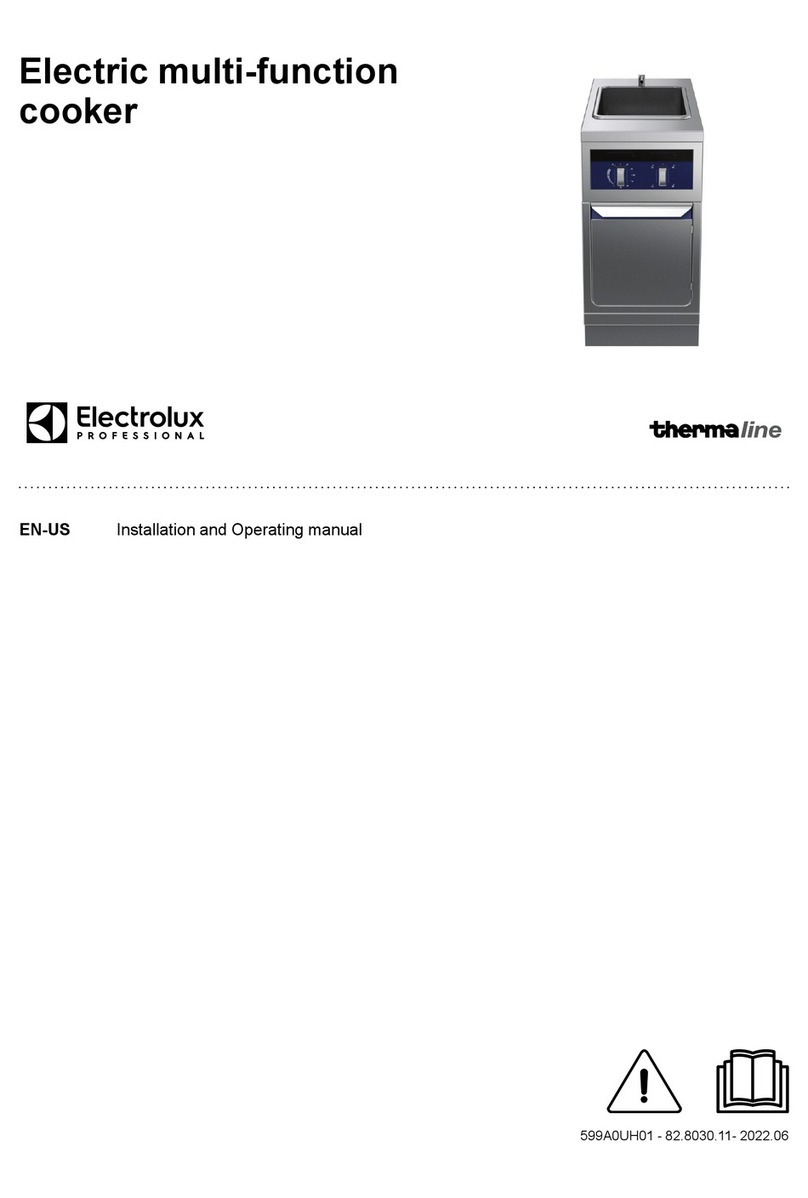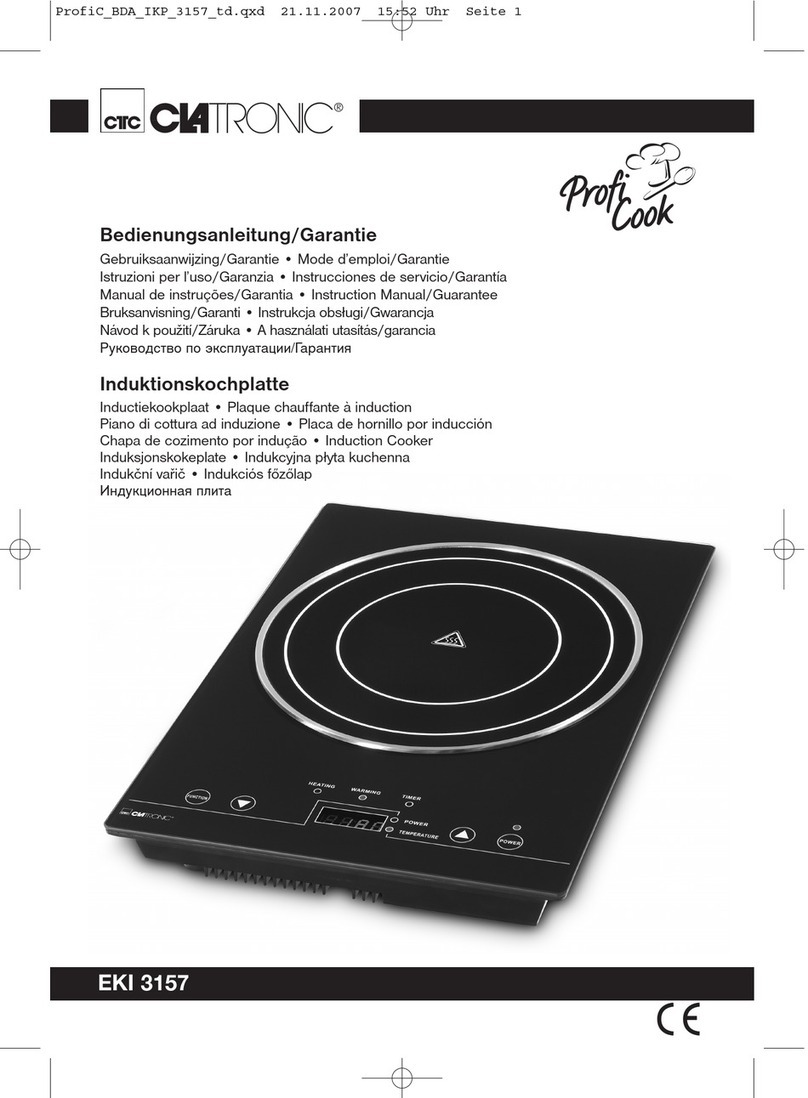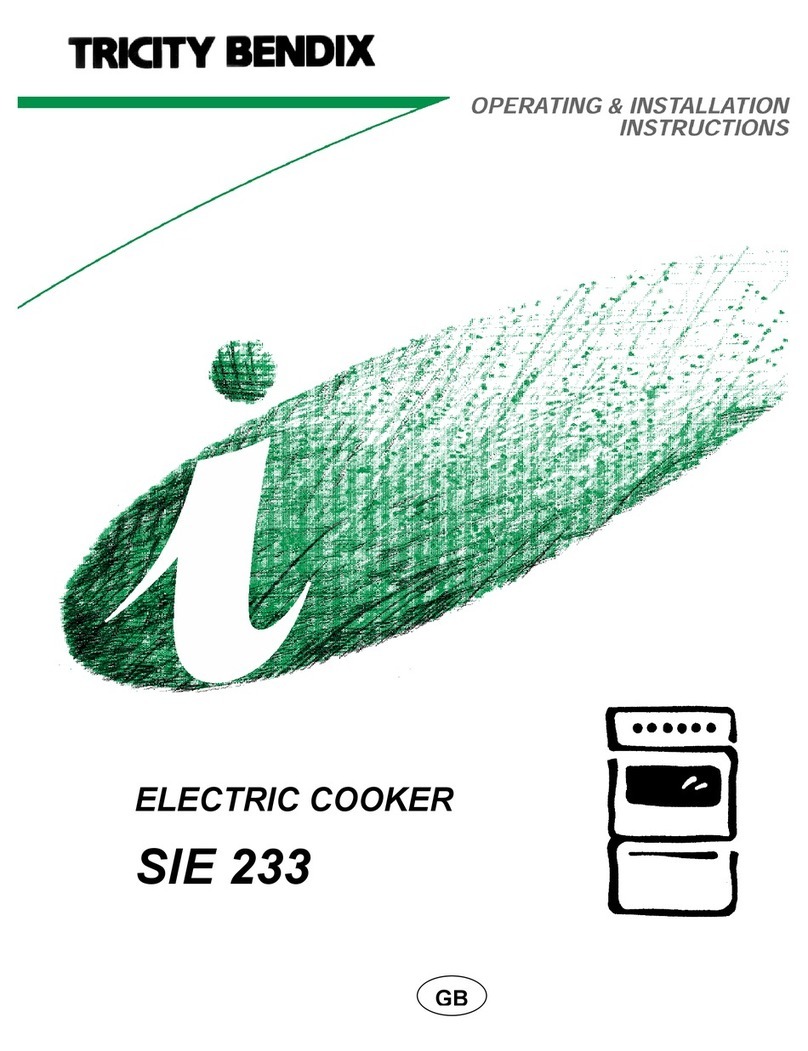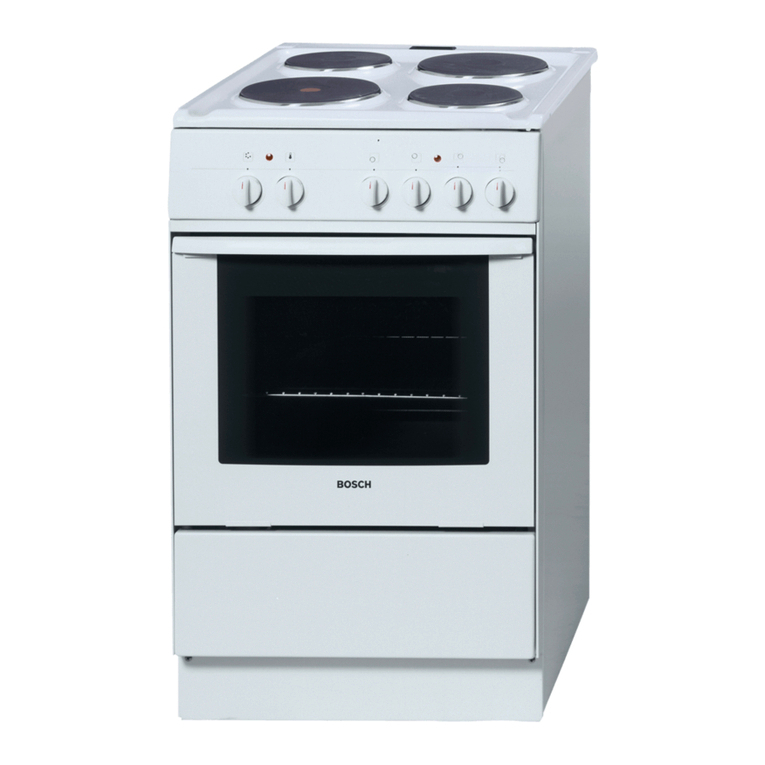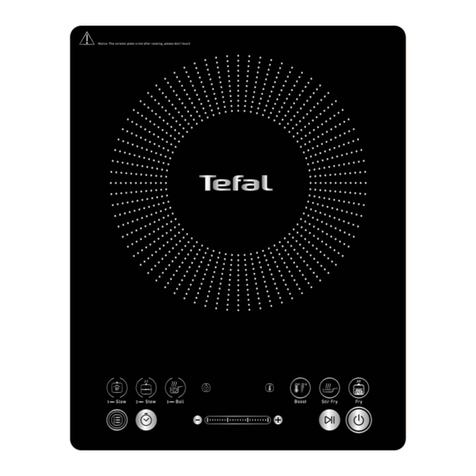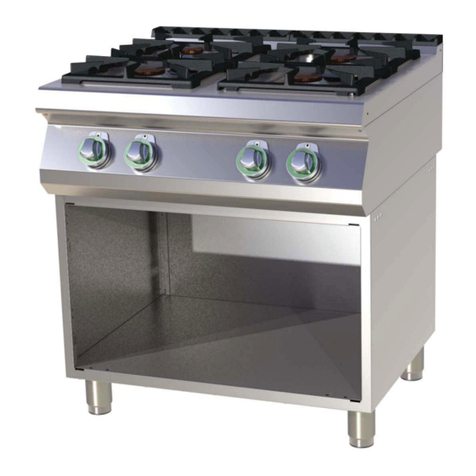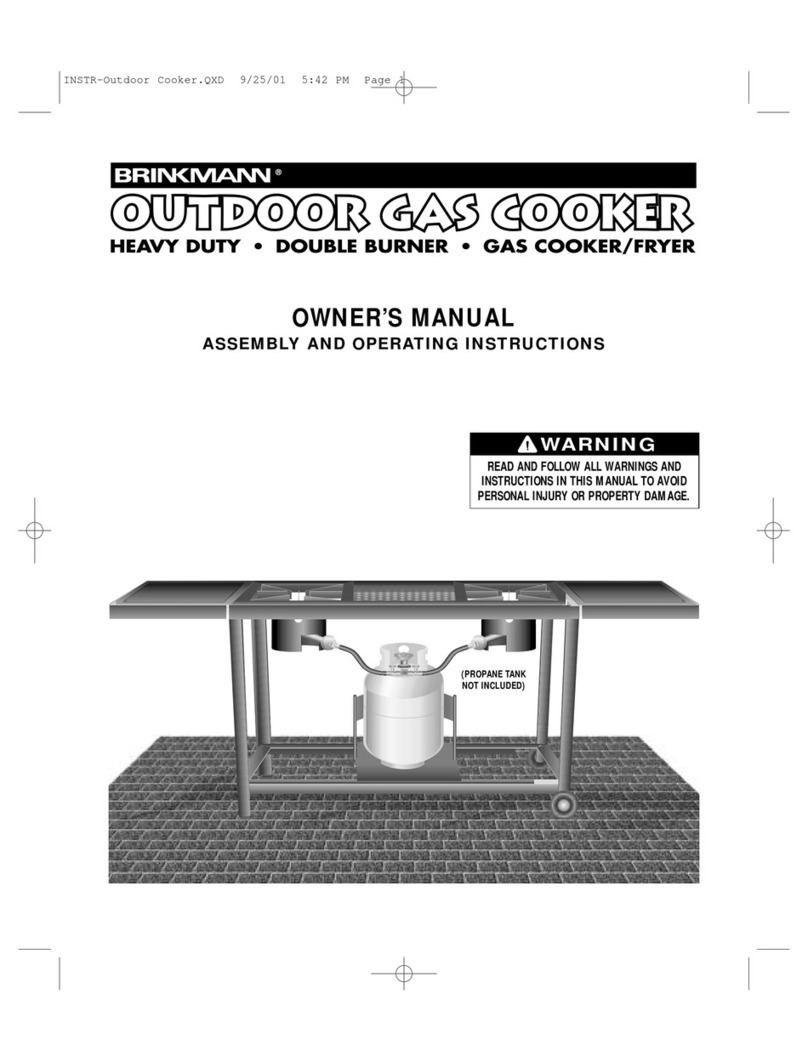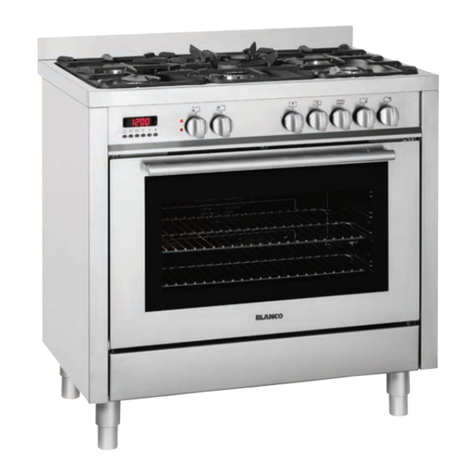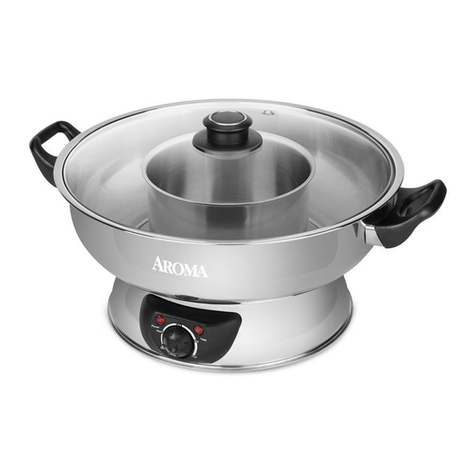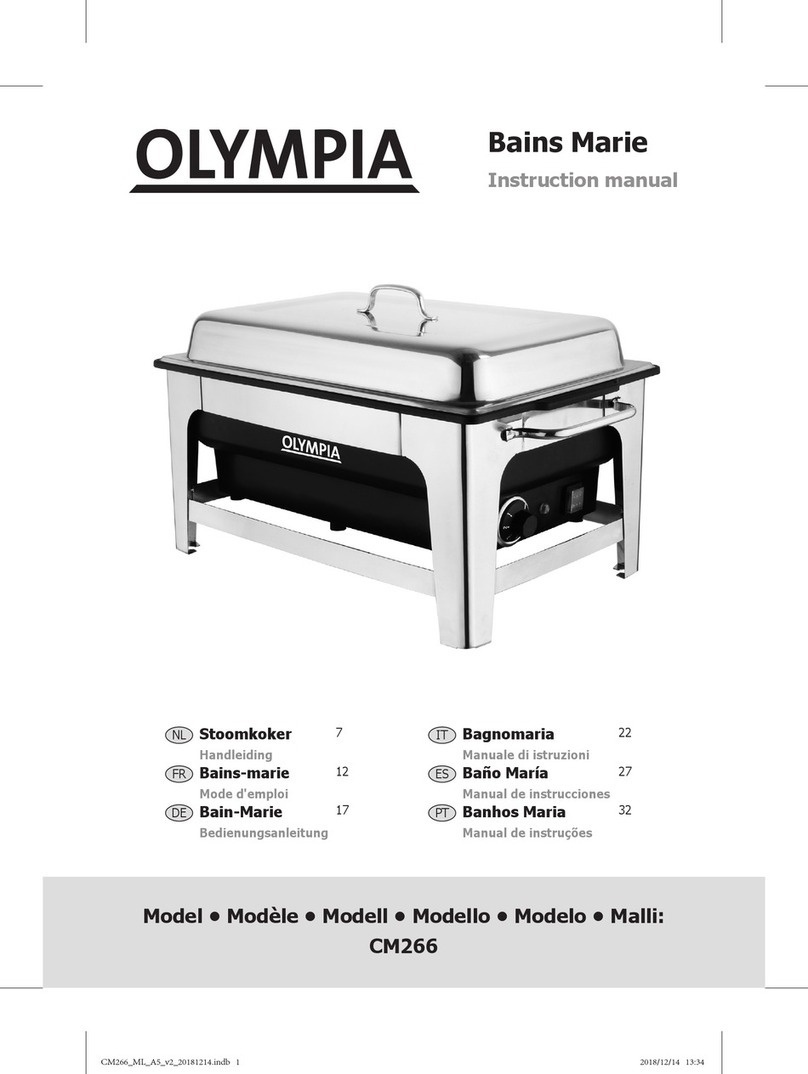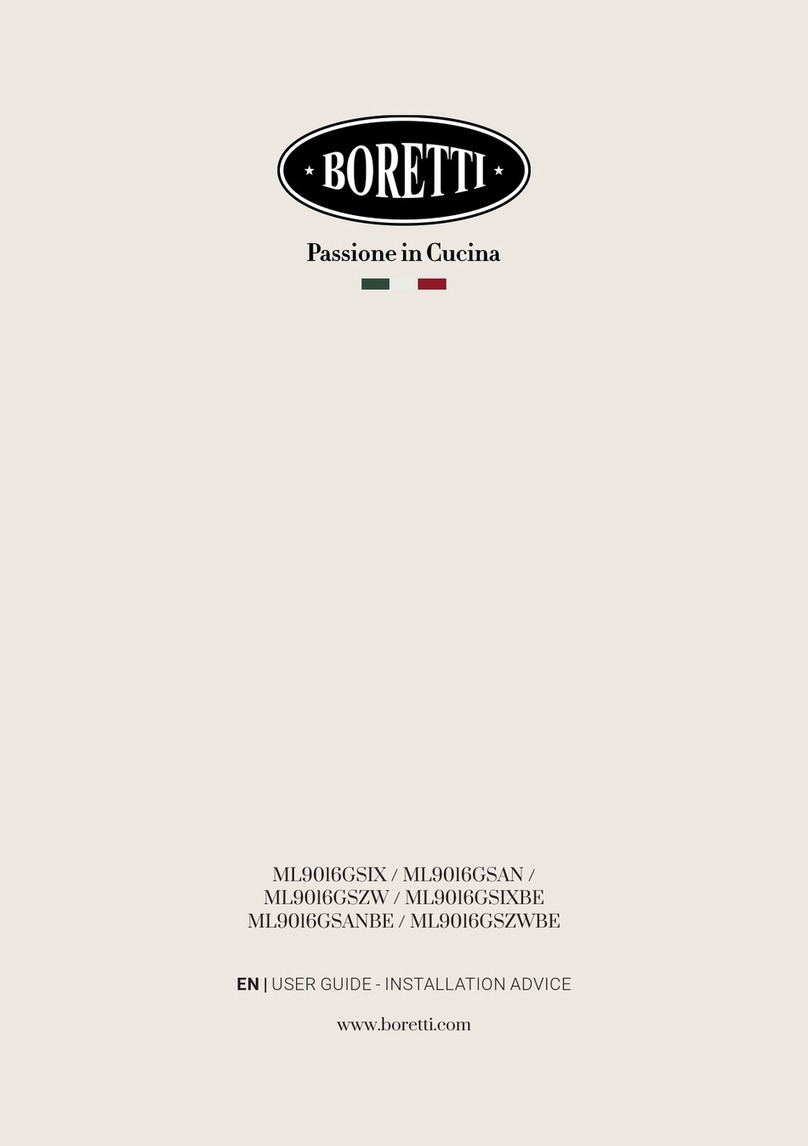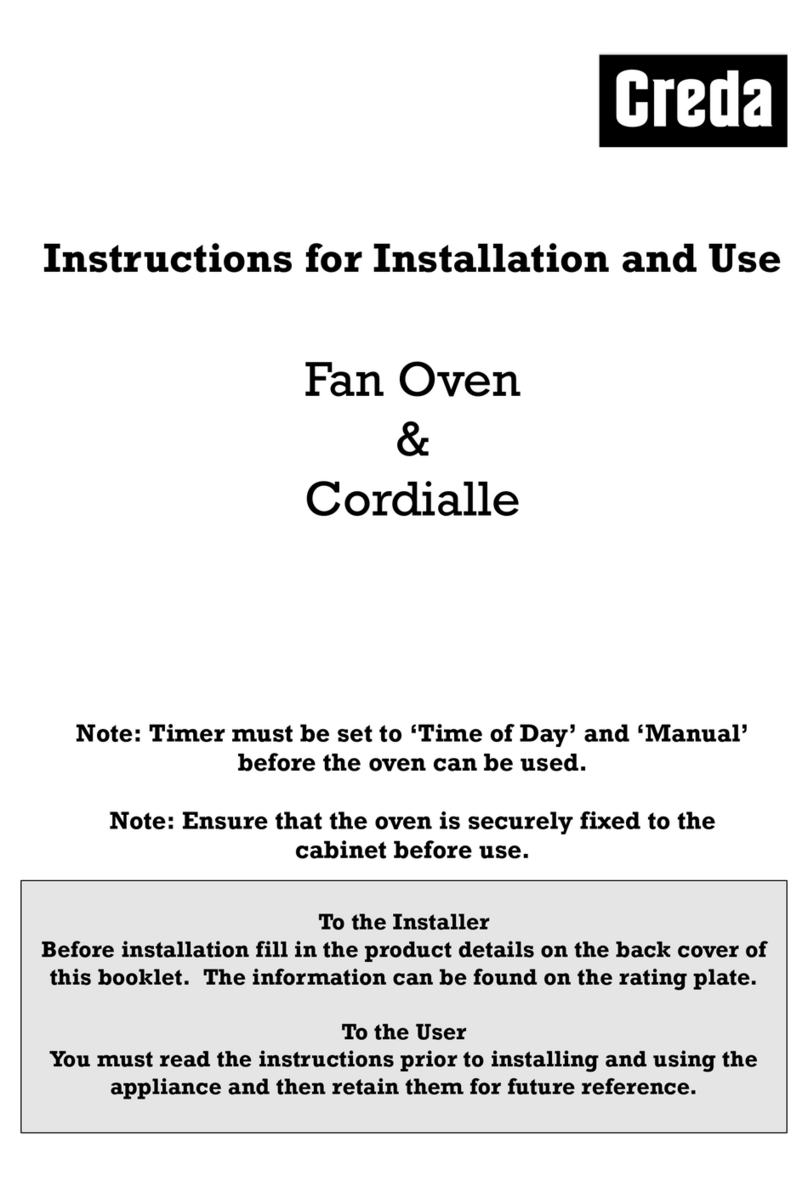Electrolux Professional Speedelight User manual

Speedelight
EN Installation and operating manual *
*Original instructions 595402902- 2022.07

2
Installation diagram

3
Installation diagram Marine

4
EI = Power cable length 2000 mm / 78.74″
EQ = Equipotential screw
A ≥ 750mm (29 1/2″) = Installation recommended
700mm (27 9/16″) ≤ A < 750mm (29 1/2″) = Mandatory fixing
the appliance to the table
A < 700mm (27 9/16″) = Not feasible
B < 64mm (2 1/2″) = Mandatory fixing the appliance to the
table

5
Foreword
Read the following instructions, including the warranty terms before installing and using the appliance.
Visit our website www.electroluxprofessional.com and open the Support section to:
Register your product
Get hints & tips of your product, service and repair information
The installation, use and maintenance manual (hereinafter Manual) provides the user with information necessary for correct and
safe use of the appliance.
The following must not be considered a long and exacting list of warnings, but rather a set of instructions suitable for improving ap-
pliance performance in every respect and, above all, preventing injury to persons and animals and damage to property due to im-
proper operating procedures.
All persons involved in appliance transport, installation, commissioning, use and maintenance, repair and disassembly must con-
sult and carefully read this manual before carrying out the various operations, in order to avoid wrong and improper actions that
could compromise the appliance's integrity or endanger people. Make sure to periodically inform the user regarding the safety reg-
ulations. It is also important to instruct and update personnel authorised to operate on the appliance, regarding its use and
maintenance.
The manual must be available to operators and carefully kept in the place where the appliance is used, so that it is always at hand
for consultation in case of doubts or whenever required.
If, after reading this manual, there are still doubts regarding appliance use, do not hesitate to contact the Manufacturer or the au-
thorised Service Centre to receive prompt and precise assistance for better operation and maximum efficiency of the appliance.
During all stages of appliance use, always respect the current regulations on safety, work hygiene and environmental protection. It
is the user's responsibility to make sure the appliance is started and operated only in optimum conditions of safety for people, ani-
mals and property.
IMPORTANT
• The manufacturer declines any liability for operations carried out on the appliance without respecting the instructions
given in this manual.
• The manufacturer reserves the right to modify the appliances presented in this publication without notice.
• No part of this manual may be reproduced.
• This manual is available in digital format by:
– contacting the dealer or reference customer care;
– downloading the latest and up to date manual on the web site www.electroluxprofessional.com;
• The manual must always be kept in an easily accessed place near the appliance. Appliance operators and mainte-
nance personnel must be able to easily find and consult it at any time.

6
Contents
A WARNING AND SAFETY INFORMATION...................................................................................................8
A.1 General information ......................................................................................................................8
A.2 Personal protection equipment ........................................................................................................ 9
A.3 General safety .............................................................................................................................9
A.4 Transport, handling and storage .................................................................................................... 10
A.5 Installation and assembly ............................................................................................................. 10
A.6 Electrical connection ................................................................................................................... 11
A.7 Use: Warnings ........................................................................................................................... 11
A.8 Appliance cleaning...................................................................................................................... 12
A.9 Preventive Maintenance............................................................................................................... 12
A.10 Parts and accessories ................................................................................................................. 13
A.11 Appliance maintenance................................................................................................................ 13
A.12 Service..................................................................................................................................... 13
A.13 Appliance disposal...................................................................................................................... 13
B WARRANTY TERMS AND EXCLUSIONS................................................................................................. 13
C GENERAL SAFETY RULES................................................................................................................... 14
C.1 Protection devices installed on the appliance .................................................................................... 14
C.2 Safety signs to be placed on the appliance or near its area .................................................................. 14
C.3 End of use ................................................................................................................................ 14
C.4 Precautions for use and maintenance ............................................................................................. 14
C.5 Reasonably foreseeable improper use ............................................................................................ 15
C.6 Residual risks ............................................................................................................................ 15
D GENERAL INFORMATION .................................................................................................................... 15
D.1 Introduction............................................................................................................................... 15
D.2 Intended use and restrictions ........................................................................................................ 15
D.3 Testing and inspection ................................................................................................................. 15
D.4 Copyright.................................................................................................................................. 15
D.5 Keeping the manual .................................................................................................................... 15
D.6 Recipients of the manual .............................................................................................................. 15
D.7 Definitions................................................................................................................................. 16
D.8 Responsibility ............................................................................................................................ 16
D.9 Customer packaging checks ......................................................................................................... 16
D.10 Storage .................................................................................................................................... 16
E TECHNICAL DATA............................................................................................................................... 16
E.1 Appliance and manufacturer's identification data ............................................................................... 16
E.2 Characteristics of power supply ..................................................................................................... 17
F INSTALLATION AND ASSEMBLY ........................................................................................................... 17
F.1 Introduction............................................................................................................................... 17
F.2 Customer's responsibilities ........................................................................................................... 17
F.3 Appliance space limits ................................................................................................................. 17
F.4 Positioning ................................................................................................................................ 18
F.4.1 Adjustment of the minimal distance between the glass and the upper plate (models equipped
only)............................................................................................................................... 18
F.5 Workplace................................................................................................................................. 18
F.6 Feet installation.......................................................................................................................... 18
F.7 Anti-opening lid device (if available in your model) ............................................................................. 18
F.8 Electrical connection ................................................................................................................... 19
F.9 Disposal of packing..................................................................................................................... 19
G NORMAL APPLIANCE USE................................................................................................................... 19
G.1 Characteristics of personnel enabled to operate on the appliance ......................................................... 20
G.2 Basic requirements for appliance use.............................................................................................. 20
H PRODUCT DESCRIPTION .................................................................................................................... 20
H.1 Appliance overview..................................................................................................................... 20
H.2 Control panel overview ................................................................................................................ 20
H.2.1 Display ........................................................................................................................... 20
H.3 Non-stick tray ............................................................................................................................ 21
I OPERATING....................................................................................................................................... 21
I.1 Start up .................................................................................................................................... 21
I.2 Set a program............................................................................................................................ 21
I.3 Basic set up settings ................................................................................................................... 22
I.4 Basic settings ............................................................................................................................ 23
I.4.1 UPLOAD / DOWNLOAD APPLIANCE AND PROGRAM SETTING INTO / FROM USB KEY ............. 23
I.4.2 DOWNLOAD LOG CYCLE INTO USB KEY ............................................................................ 23
I.4.3 UPLOAD / DOWNLOAD PROGRAM SETTINGS INTO / FROM USB KEY .................................... 23
I.4.4 UPLOAD / DOWNLOAD APPLIANCE SETTINGS INTO / FROM USB KEY................................... 23
I.4.5 COUNTERS CONTROL..................................................................................................... 24
I.4.6 BRIGHTNESS.................................................................................................................. 24
I.4.7 BUZZER SET UP.............................................................................................................. 24
I.4.8 MELODY SET UP............................................................................................................. 24
I.4.9 TIME SETTING ................................................................................................................ 24
I.4.10 INFO DATA...................................................................................................................... 24
I.4.11 CONNECTIVITY............................................................................................................... 25

7
I.5 Advanced settings ...................................................................................................................... 25
I.5.1 Access to Advanced settings ............................................................................................... 25
I.5.2 PROGRAM SETTING - Single Phase.................................................................................... 25
I.5.3 FLEX (models equipped only) .............................................................................................. 26
I.5.4 PROGRAM SETTING Multiphase......................................................................................... 26
I.5.5 UPLOAD / DOWNLOAD APPLIANCE AND PROGRAM SETTING INTO/FROM USB KEY ............... 27
I.5.6 START MODE SETTING .................................................................................................... 27
I.5.7 STOP CYCLE OPTION SETTING ........................................................................................ 27
I.5.8 UPPER PLATE AND GLASS TEMPERATURE SETTING .......................................................... 28
I.5.9 STAND-BY SETTING ........................................................................................................ 28
I.5.10 COUNTERS CONTROL ..................................................................................................... 28
I.5.11 BRIGHTNESS.................................................................................................................. 28
I.5.12 BUZZER SET UP – TIME SETTING – INFO DATA ................................................................... 28
I.5.13 CHANGE PASSWORD ...................................................................................................... 29
I.5.14 RESET PASSWORD ......................................................................................................... 29
I.5.15 EXPERT - UNEXPERT SETTING ......................................................................................... 29
I.5.16 IMAGE MENU SETTING .................................................................................................... 30
I.5.17 CONNECTIVITY SETTING ................................................................................................. 30
I.5.18 RECIPES MANAGEMENT FROM CLOUD (if available in your model).......................................... 30
I.6 Daily use .................................................................................................................................. 30
J REMOVABLE TEFLON PLATE (RTP) ...................................................................................................... 31
J.1 Precautions for use..................................................................................................................... 31
J.2 Unlock the upper plate ................................................................................................................. 31
J.3 Replace the Removable Teflon Plate .............................................................................................. 32
J.4 Fix the upper plate in the lid .......................................................................................................... 32
K APPLIANCE CLEANING ....................................................................................................................... 32
K.1 Cleaning introduction................................................................................................................... 32
K.2 External cleaning........................................................................................................................ 32
K.3 Daily cleaning ............................................................................................................................ 33
K.3.1 Preliminary actions ............................................................................................................ 33
K.3.2 Glass and lid.................................................................................................................... 33
K.3.3 Choke or choke cover cleaning ............................................................................................ 33
K.3.4 Cooking chamber.............................................................................................................. 34
K.3.5 Food tray cleaning............................................................................................................. 34
K.3.6 Steam exhaust chamber ..................................................................................................... 35
K.4 Weekly cleaning ......................................................................................................................... 35
K.4.1 Clean the Removable Teflon Plate ........................................................................................ 35
K.4.2 Cooking chamber deep cleaning .......................................................................................... 35
K.4.3 Filters cleaning ................................................................................................................. 36
L APPLIANCE MAINTENANCE................................................................................................................. 36
L.1 Care information......................................................................................................................... 36
L.2 Decommissioning ....................................................................................................................... 36
L.3 Disassembly.............................................................................................................................. 36
L.4 Maintenance intervals.................................................................................................................. 36
L.5 Periods of non-use...................................................................................................................... 37
M TROUBLESHOOTING .......................................................................................................................... 37
M.1 Introduction............................................................................................................................... 37
M.2 Suggestions for quality cooking ..................................................................................................... 38
M.3 Anomaly table............................................................................................................................ 38
N APPLIANCE DISPOSAL........................................................................................................................ 44
N.1 Procedure regarding appliance disposal .......................................................................................... 44

8
A WARNING AND SAFETY INFORMATION
A.1 General information
To ensure safe use of the appliance and a proper understanding of the manual it is
necessary to be familiar with the terms and typographical conventions used in the
documentation. The following symbols are used in the manual to indicate and identify the
various types of hazards:
WARNING
Danger for the health and safety of operators.
WARNING
Danger of electrocution - dangerous voltage.
CAUTION
Risk of damage to the appliance or the product.
IMPORTANT
Important instructions or information on the product
Equipotentiality
Read the instructions before using the appliance
Clarifications and explanations
• Only specialised personnel are authorised to operate on the appliance.
• This appliance must not be used by minors and adults with limited physical, sensory or
mental abilities or without adequate experience and knowledge regarding its use.
• Do not let children use or play with the appliance.
• Cleaning and user maintenance shall not be made by children.
• Refer to the data given on the appliance’s data plate for relations with the Manufacturer
(e.g. when ordering spare parts, etc.).
• When scrapping the appliance, the marking must be destroyed.
• Save these instructions carefully for further consultation by the various operators.

9
A.2 Personal protection equipment
Summary table of the Personal Protection Equipment (PPE) to be used during the various
stages of the appliance's service life.
Stage Protective
garments
Safety
footwear
Gloves Glasses Safety
helmet
Transport ● ● ○ — —
Handling ● ● ○ — —
Unpacking ● ● ○ ○ —
Installation ● ● ●1— —
Normal use ○ ○ ○2— —
Adjustments ○ ○ ○ — —
Routine
cleaning
○ ● ●1ˉ2ˉ3●—
Extraordi-
nary
cleaning
○ ● ●1ˉ2ˉ3●—
Maintenance ● ● ○ — —
Dismantling ● ● ○ ○ —
Scrapping ● ● ○ ○ —
Key:
●PPE REQUIRED
○PPE AVAILABLE OR TO BE USED IF NECESSARY
—PPE NOT REQUIRED
1. During these operations, gloves must be cut-resistant. Failure to use the personal protection equipment by
operators, specialized personnel or users can involve exposure to damage to health (depending on the model).
2. During these operations, gloves must be heatproof to protect hands from contact with hot food or hot parts of
the appliance and/or when removing hot items from it. Failure to use the personal protection equipment by
operators, specialised personnel or users can involve exposure to chemical risk and cause possible damage to
health (depending on the model).
3. During these operations, gloves must be suitable for contact with chemical substances used (refer to the
safety data sheet of the substances used for information regarding the required PPE). Failure to use the
personal protection equipment by operators, specialized personnel or users can involve exposure to chemical
risk and cause possible damage to health (depending on the model).
A.3 General safety
• The appliances are provided with electric and/or mechanical safety devices for
protecting workers and the appliance itself.
• Never operate the appliance, removing, modifying or tampering with the guards,
protection or safety devices.
• Do not make any modifications to the parts supplied with the appliance.
• Several illustrations in the manual show the appliance, or parts of it, without guards or
with guards removed. This is purely for explanatory purposes. Do not use the appliance
without the guards or with the protection devices deactivated.

10
Disconnect the appliance from the power
supply before carrying out any installation,
assembly, cleaning or maintenance
procedure.
• Do not remove, tamper with or make illegible the marking and safety, danger and
instruction signs and labels on the appliance.
• The A-weighted emission sound pressure level does not exceed 70 dB(A).1
• Carefully avoid exposure of the equipment to ozone - do not use ozonizers in the rooms
where the equipment is installed.
• The following operations have to be carried out by specialised authorised personnel or
Customer Care Service provided with all the appropriate personal protection equipment
(A.2 Personal protection equipment), tools, utensils and ancillary means, who can ask
the manufacturer to supply a servicing manual:
– Installation and assembly
– Positioning
– Electrical connection
– Appliance cleaning, repair and extraordinary maintenance
– Appliance disposal
– Work on electrical equipment
A.4 Transport, handling and storage
• Transport (i. e. transfer of the appliance from one place to another) and handling (i.e.
transfer inside workplaces) must occur with the use of special and adequate means.
• Please refer to indications on packaging for stackability during transport, handling and
storage.
• Do not stand under suspended loads during loading or unloading operations.
Unauthorized personnel must not enter the work area.
• The weight of the appliance alone is not sufficient to keep it steady.
• For appliance handling, do not lift and anchor it to movable or weak parts such as:
casings, electrical raceways, pneumatic parts, etc.
• Do not push or pull the appliance to move it, as it may tip over. Use proper tool to lift the
appliance.
• Arrange a suitable area with flat floor for appliance unloading and storage operations.
• Appliance transport, handling, shifting and storage personnel must be adequately
instructed and trained regarding the safely use of lifting systems and personal protection
equipment suitable for the type of operation carried out.
• When removing the anchoring systems, make sure the stability of the appliance parts
does not depend on the anchoring and, therefore, that this operation does not cause the
load to fall off the vehicle. Before unloading the appliance components, make sure all
the anchoring systems are removed.
A.5 Installation and assembly
• The operations described must be carried out in compliance with the current safety
regulations and provisions in force in the country of use.
• The plug, if present, must be accessible after positioning the appliance in the place of
installation.
ON
OFF
1. The noise emission values have been obtained according to EN ISO 11204. The value could increase depending on the workplace where
measured.

11
• The appliance is not suitable for installation outdoors and/or in places exposed to
atmospheric agents (rain, direct sunlight, etc.).
A.6 Electrical connection
• The power supply system must be suitable for the rated current of the connected
appliance; the connection must be carried out in compliance with the regulations and
provisions in force in the country of use.
• The information regarding the appliance power supply voltage and frequency is given on
the data plate.
• If the power cable is damaged or too short, it must be replaced by the Customer Care
Service or in any case by specialised personnel, in order to prevent any risk.
• The manufacturer declines any liability for damage or injury resulting from breach of the
above rules or non-compliance with the electrical safety regulations in force in the
country where the appliance is used.
A.7 Use: Warnings
To reduce the risk of burns, electric shock, fire, injury to persons, or exposure to
excessive microwave energy
1. Read all instructions before using the appliance.
2. Read and follow the specific PRECAUTIONS FOR SAFE USE TO AVOID POSSIBLE
EXPOSURE TO EXCESSIVE MICROWAVE ENERGY inGNormal appliance use
chapter.
3. Do not use the appliance without any load.
4. This appliance must be grounded. Connect only to properly grounded outlet. See
"GROUNDING INSTRUCTIONS" in F.8 Electrical connection chapter.
5. Install or locate this appliance only in accordance with the provided installation
instructions.
6. Some products such as whole eggs and sealed containers – for example, closed glass
jars – can explode and should not be heated in this appliance.
IMPORTANT
Make sure to apply in a conspicuous place and close to the appliance, the
following information supplied: “Warning: liquids or other foods must not
be heated in sealed containers since they are liable to explode.“
7. Use this appliance only for its intended use as described in the manual. Do not use
corrosive chemicals or vapors in this appliance. This type of appliance is specifically
designed to heat, cook sandwiches. It is not designed for laboratory use.
8. The appliance is intended only for professional use, not for household application.
9. As with any professional appliance, it cannot be use by unqualified people or children.
10.Do not operate this appliance if it has a damaged cord or plug, if it is not working
properly, or if it has been damaged or dropped.
11. Do not use the appliance if it is damaged. It is particularly important that the lid close
properly and that there is no damage on the glass.
12.Before each use, the user is responsible of verifying the general integrity and
cleanliness of the appliance and stop or no using it in case of noted dirt, damage or
missing parts.
13.This appliance should be serviced only by qualified service personnel. Contact
nearest authorized service facility for examination, repair, or adjustment.
14.The appliance has an internal air-cooling system (back and front). The air intake and
outlet openings of the appliance must not be blocked with objects or cloths, otherwise

12
excessive overheating and damage to the appliance could occur. Do not place objects
on the outlets located at the top of the appliance.
15.Do not store this appliance outdoors. Do not use this product near water – for example,
near a kitchen sink, in a wet basement, near a swimming pool, or similar locations.
16.Do not immerse the appliance, the upper heating plate, cord or plug in water.
17.Keep the power cord away from any heated surfaces of the appliance.
18.Do not let cord hang over edge of table or counter.
19.To reduce the risk of fire in the heating cavity:
a. The appliance is designed for direct heating/cooking of sandwich. Any other use is to
be considered improper.
b. Do not overcook sandwiches. DO NOT place plastic or other combustible materials,
cooking utensils or other item (in all materials it could be) inside the appliance. Place
ONLY sandwiches, with the designated specific baking paper (for models equipped).
c. If materials inside the appliance ignite, turn appliance off and disconnect the power
cord.
d. Do not leave things on the glass, do not use the cooking chamber for storage
purposes. Do not leave cooking utensils or sandwiches in the cavity when not in use.
e. Do not use the appliance to warm sandwich in metallic pots, pans, sheets, utensils.
f. Clean regularly the glass and the upper heating plate, removing all the debris. Carbon
deposit could overheat the sandwiches and the microwaves can burn the grease and
burned deposit.
20.The maximum height of the sandwich to be cooked must not overpass 3″/75 mm.
21.During operation, pay attention to the hot zones of the exterior surface. The cooking
zones remain hot. Even with the appliance switched off.
22.As in any microwave appliance, sparks can occur inside the cooking chamber. These
sparks do not influence the safety of the user nor the appliance nor the quality of the
sandwich. If, because of the sparking, a dark mark on the metal part is visible, this can
be cleaned with a damp cloth.
23.Periodically clean the appliance, removing all traces of sandwich; failure to keep it
clean will lead to deterioration of the surfaces.
24.The supplied tool (scraper) shall to be used only for cleaning purpose. See K.3 Daily
cleaning chapter.
25.Have the appliance fully checked periodically (at least once a year). For that purpose,
it is advisable to stipulate a maintenance contract.
26.It is hazardous for anyone other than a competent person to carry out any service or
repair operation that removal of any cover which gives protection against exposure to
microwave energy
SAVE THESE INSTRUCTIONS CAREFULLY FOR FURTHER CONSULTATION BY THE
VARIOUS OPERATORS
A.8 Appliance cleaning
• Do not touch the appliance with wet hands or feet or when barefoot.
• Put the appliance in safe conditions before starting any cleaning operation.
• Respect the requirements for the various routine and extraordinary maintenance
operations. Non-compliance with the instructions can create risks for personnel.
• Do not spray water or use water jets, steam cleaner or high pressure cleaner.
A.9 Preventive Maintenance
In order to ensure the safety and performance of your equipment, it is recommended that
service is undertaken by Electrolux Professional authorised engineers every 12 months, in

13
accordance with Electrolux Professional Service Manuals. Please contact your local
Electrolux Professional Service Centre for further details.
A.10 Parts and accessories
Use only original accessories and/or spare parts. Failure to use original accessories and/or
spare parts will invalidate the original manufacturer warranty and may render the appliance
not compliant with the safety standard.
A.11 Appliance maintenance
• The inspection and maintenance intervals depend on the actual appliance operating
conditions and ambient conditions (presence of dust, damp, etc.), therefore precise time
intervals cannot be given. In any case, careful and periodical appliance maintenance is
advisable in order to minimise service interruptions.
• It is advisable to stipulate a preventive and scheduled maintenance contract with the
Customer Care Service.
• Put the appliance in safe conditions before starting any maintenance operation.
• The plug must be in a position always visible to the operator performing the intervention
during maintenance operations.
• To guarantee appliance efficiency and correct operation, periodical maintenance must
be carried out according to the instructions given in the manual.
A.12 Service
PRECAUTIONS TO BE OBSERVED BEFORE AND DURING SERVICING TO AVOID
POSSIBLE EXPOSURE TO EXCESSIVE MICROWAVE ENERGY
• Do not operate or allow the appliance to be operated with the lid open.
• Make the following safety checks on all appliances to be serviced before activating the
magnetron or other microwave source, and make repairs as necessary:
1. interlock operation
2. proper lid closing
3. seal and sealing surfaces (arcing, wear, and other damage)
4. damage to or loosening of hinges and latches
5. evidence of dropping or abuse
• Only original spare parts can ensure the safety standards of the appliance.
• Before turning on microwave power for any service test or inspection within the
microwave generating compartments, check the magnetron, wave guide or
transmission line, and cavity for proper alignment, integrity, and connection.
• Any defective or misadjusted components in the interlock, monitor, lid seal, and
microwave generation and transmission systems shall be repaired, replaced, or
adjusted by procedures described in this manual before the appliance is released to
the owner.
A.13 Appliance disposal
• Make the appliance unusable by removing the power cable and any compartment
closing devices, to prevent the possibility of someone becoming trapped inside.
B WARRANTY TERMS AND EXCLUSIONS
If the purchase of this product includes warranty coverage,
warranty is provided in line with local regulations and subject to
the product being installed and used for the purposes as
designed, and as described within the appropriate equipment
documentation.
Warranty will be applicable where the customer has used only
genuine spare parts and has performed maintenance in
accordance with Electrolux Professional user and mainte-
nance documentation made available in paper or electronic
format.

14
Electrolux Professional strongly recommends using Electrolux
Professional approved cleaning, rinse and descaling agents to
obtain optimal results and maintain product efficiency over
time.
The Electrolux Professional warranty does not cover:
• service trips cost to deliver and pick up the product;
• installation;
• training on how to use/operate;
• replacement (and/or supply) of wear and tear parts unless
resulting from defects in materials or workmanship reported
within one (1) week from the failure;
• correction of external wiring;
• correction of unauthorized repairs as well as any damages,
failures and inefficiencies caused by and/or resulting from;
– insufficient and/or abnormal capacity of the electrical
systems (current/voltage/frequency, including spikes and/or
outages);
– inadequate or interrupted water supply, steam, air, gas
(including impurities and/or other that does not comply with
the technical requirements for each appliance);
– plumbing parts, components or consumable cleaning
products that are not approved by the manufacturer;
– customer’s negligence, misuse, abuse and/or non-com-
pliance with the use and care instructions detailed within the
appropriate equipment documentation;
– improper or poor: installation, repair, maintenance
(including tampering, modifications and repairs carried out
by third parties not authorized) and modification of safety
systems;
– Use of non-original components (e. g.: consumables,
wear and tear, or spare parts);
– environment conditions provoking thermal (e. g. over-
heating/freezing) or chemical (e. g. corrosion/oxidation)
stress;
– foreign objects placed in- or connected to- the product;
– accidents or force majeure;
– transportation and handling, including scratches, dents,
chips, and/or other damage to the finish of the product,
unless such damage results from defects in materials or
workmanship and is reported within one (1) week of delivery
unless otherwise agreed;
• product with original serial numbers that have been
removed, altered or cannot be readily determined;
• replacement of light bulbs, filters or any consumable parts;
• any accessories and software not approved or specified by
Electrolux Professional.
Warranty does not include scheduled maintenance activities
(including the parts required for it) or the supply of cleaning
agents unless specifically covered within any local agreement,
subject to local terms and conditions.
Check on Electrolux Professional website the list of authorized
customer care.
C GENERAL SAFETY RULES
WARNING
Refer to “Warning and safety
information“.
C.1 Protection devices installed on the
appliance
Guards
The appliance has:
• fixed guards (e.g. casings, covers, side panels, etc.), fixed
to the appliance and/or frame with screws or quick-release
connectors that can only be removed or opened with tools;
therefore the user must not remove or tamper with such
devices. The Manufacturer declines any liability for damage
due to tampering or their non-use;
• interlocked movable guards (door) for access inside the
appliance;
• appliance electrical equipment access panels or doors,
made from hinged panels openable with tools. The panel
or the door must not be opened when the appliance is
connected to the power supply.
C.2 Safety signs to be placed on the
appliance or near its area
Prohibition Meaning
do not remove the safety devices
do not use water to extinguish fires
(placed on electrical parts)
Danger Meaning
danger of crushing hands
caution hot surface
danger of electrocution (shown on elec-
trical parts with indication of voltage)
C.3 End of use
When the appliance is no longer to be used, make it unusable
by removing the mains power supply wiring.
C.4 Precautions for use and maintenance
• Risks mainly of a mechanical, thermal and electrical nature
exist in the appliance. Where possible the risks have been
neutralised:
– directly, by means of adequate design solutions.
– indirectly by using guards, protection and safety devices.
• Any anomalous situations are signalled on the control panel
display.
• During maintenance several risks remain, as these could
not be eliminated, and must be neutralised by adopting
specific measures and precautions.
• Do not carry out any checking, cleaning, repair or main-
tenance operations on moving parts. Workers must be
informed of this prohibition by means of clearly visible signs.
• Make sure to periodically check correct operation of all the
safety devices and the insulation of electrical cables, which
must be replaced if damaged.
In case of a significant anomaly (e. g. short circuits, wires
coming out of the terminal block, motor breakdowns, worn

15
electrical cable sheathing, etc.) the operator for normal
appliance use must:
• immediately deactivate the appliance and disconnect all the
supplies (electricity, gas, water).
C.5 Reasonably foreseeable improper use
Improper use is any use different from that specified in this
manual. During appliance operation, other types of work or
activities deemed improper and that in general can involve
risks for the safety of operators and damage to the appliance
are not allowed. Reasonably foreseeable improper use
includes:
• lack of appliance maintenance, cleaning and periodical
checks;
• structural changes or modifications to the operating logic;
• tampering with the guards or safety devices;
• failure to use personal protection equipment by operators,
specialised personnel and maintenance personnel;
• failure to use suitable accessories (e.g. use of unsuitable
equipment or ladders);
• keeping combustible or flammable materials, or in any case
materials not compatible with or pertinent to the work, near
the appliance;
• wrong appliance installation;
• placing in the appliance any objects or things not compat-
ible with its use, or that can damage the appliance, cause
injury or pollute the environment;
• climbing on the appliance;
• non-compliance with the requirements for correct appliance
use;
• other actions that give rise to risks not eliminable by the
Manufacturer.
C.6 Residual risks
The appliance has several risks that were not completely
eliminated from a design standpoint or with the installation of
adequate protection devices. Nevertheless, through this
manual the Manufacturer has taken steps to inform operators
of such risks, carefully indicating the personal protection
equipment to be used by them. In order to reduce the risks,
provide for sufficient spaces while installing the unit.
To preserve these conditions, the areas around the appliance
must always be:
• kept free of obstacles (e.g. ladders, tools, containers, boxes,
etc.);
• clean and dry;
• well lit.
For the Customer's complete information, the residual risks
remaining on the appliance are indicated below: such actions
are deemed improper and therefore strictly forbidden.
Residual risk Description of hazardous
situation
Slipping or falling The operator can slip due to water,
any liquid or dirt on the floor
Burns/abrasions (e.g.
heating elements,
cold pan, cooling cir-
cuit plates and pipes)
The operator deliberately or unin-
tentionally touches some
components inside the appliance
without using protective gloves.
Electrocution Contact with live parts during
maintenance operations carried
out with the electrical panel
powered
Crushing or shearing Possible risk of injury to upper
limbs during the closing operation
of the appliance lid.
Tipping of loads When handling the appliance or
the packing containing it, using
unsuitable lifting systems or
accessories or with the unbal-
anced load
Chemical Contact with chemical substances
(e.g. detergent, rinse aid, scale
remover, etc.) without taking
adequate safety precautions.
Therefore always refer to the
safety cards and labels on the
products used.
D GENERAL INFORMATION
D.1 Introduction
This manual contains information relevant to various applian-
ces. The product images in this guide are only an example.
The drawings and diagrams given in the manual are not in
scale. They supplement the written information with an outline,
but are not intended to be a detailed representation of the
appliance supplied.
The numerical values given on the appliance installation
diagrams refer to measurements in millimeters and/or inches.
D.2 Intended use and restrictions
This appliance is designed for heating/cooking snacks.
Any other use is deemed improper.
NOTE!
The manufacturer declines any liability for
improper use of the product.
D.3 Testing and inspection
Our appliances have been designed and optimized, with
laboratory testing, in order to obtain high performance and
efficiency.
The appliance is shipped ready for use.
Passing of the tests (visual inspection - electrical test -
functional test) is guaranteed and certified by the specific
enclosures.
D.4 Copyright
This manual is intended solely for consultation by the operator
and can only be given to third parties with the permission of
Electrolux Professional company.
D.5 Keeping the manual
The manual must be carefully kept for the entire life of the
appliance, until scrapping. The manual must stay with the
appliance in case of transfer, sale, hire, granting of use or
leasing.
D.6 Recipients of the manual
This manual is intended for:
• the carrier and handling personnel;
• installation and commissioning personnel;
• the employer of appliance users and the workplace
manager;
• operators for normal appliance use;
• specialised personnel - Customer Care service (see service
manual).

16
D.7 Definitions
Listed below are the definitions of the main terms used in the
manual. It is advisable to read them carefully before use.
Operator appliance installation, adjustment, use,
maintenance, cleaning, repair and trans-
port personnel.
Manufacturer Electrolux Professional SpA or any other
service centre authorised by Electrolux
Professional SpA.
Operator for
normal appli-
ance use
an operator who has been informed and
trained regarding the tasks and hazards
involved in normal appliance use.
Customer
Care service
or specialised
personnel
an operator instructed/trained by the
Manufacturer and who, based on his
professional and specific training, experi-
ence and knowledge of the accident-
prevention regulations, is able to appraise
the operations to be carried out on the
appliance and recognise and prevent any
risks. His professionalism covers the
mechanical, electrotechnical and elec-
tronics fields etc.
Danger source of possible injury or harm to health.
Hazardous
situation
any situation where an operator is
exposed to one or more hazards.
Risk a combination of probabilities and risks of
injury or harm to health in a hazardous
situation.
Protection
devices
safety measures consisting of the use of
specific technical means (guards and
safety devices) for protecting operators
against risks.
Guard an element of a appliance used in a
specific way to provide protection by
means of a physical barrier.
Safety device a device (other than a guard) that elimi-
nates or reduces the risk; it can be used
alone or in combination with a guard.
Customer the person who purchased the appliance
and/or who manages and uses it (e. g.
company, entrepreneur, firm).
Electrocution an accidental discharge of electric current
on a human body.
D.8 Responsibility
The Manufacturer declines any liability for damage and
malfunctioning caused by:
• non-compliance with the instructions contained in this
manual;
• repairs not carried out in a workmanlike fashion, and
replacements with parts different from those specified in
the spare parts catalogue (the fitting and use of non-original
spare parts and accessories can negatively affect appliance
operation and invalidates the original manufacturer
warranty);
• operations carried out by non-specialised personnel;
• unauthorized modifications or operations;
• missing, lack or inadequate maintenance;
• improper appliance use;
• unforeseeable extraordinary events;
• use of the appliance by uninformed and / or untrained
personnel;
• non-application of the current provisions in the country of
use, concerning safety, hygiene and health in the workplace.
The Manufacturer declines any liability for damage caused by
arbitrary modifications and conversions carried out by the user
or the Customer.
The employer, workplace manager or service technician are
responsible for identifying and choosing adequate and suitable
personal protection equipment to be worn by operators, in
compliance with regulations in force in the country of use.
The Manufacturer declines any liability for inaccuracies con-
tained in the manual, if due to printing or translation errors.
Any supplements to the installation, use and maintenance
manual the Customer receives from the Manufacturer will form
an integral part of the manual and therefore must be kept
together with it.
D.9 Customer packaging checks
• The forwarder is responsible for the goods during transport
and delivery.
• Make a complaint to the forwarder in case of visible or
hidden damage.
• Specify any damage or shortages on the dispatch note.
• The driver must sign the dispatch note: the forwarder can
reject the claim if the dispatch note is not signed (the
forwarder can provide the necessary form).
• For hidden damage or shortages becoming apparent only
after unpacking, request the forwarder for inspection of the
goods within and no later than 15 days after delivery.
After packaging checks
1. Remove the packaging.
Take care when unpacking and handling of the appliance
to not cause any shocks on itself.
2. Keep all the documentation contained in the packaging.
D.10 Storage
The appliance and/or its parts must be stored and protected
from damp, in a non-aggressive place, free of vibrations and
with room temperatures between –10 ℃[14 ℉] and 50 ℃[122
℉].
The place where the appliance is stored must:
• can take the appliance load,
• have a flat support surface to avoid deforming the appliance
or damage to the support feet.
E TECHNICAL DATA
E.1 Appliance and manufacturer's
identification data
The data plate gives the product identification and technical
data.
An example of the marking or data plate on the appliance is
given below:

17
The meaning of the various information given on it is listed
below:
F.Mod. factory description of product
Comm.Mod. commercial description
PNC production number code
Ser.No. serial number
Type ref. certification group of the appliance
V power supply voltage
Hz power supply frequency
kW power input
A absorbed current
MW freq microwaves frequency
CE marking
WEEE symbol
IPX4 dust and water protection rating
E.2 Characteristics of power supply
The AC power supply to the machine must meet the following
conditions:
• max. voltage variation ± 5%
• max. frequency variation ± 1% continuous ± 2% for a short
period.
Harmonic distortion, unbalanced three-phase supply voltage,
voltage pulses, interruption, dips and the other electric
characteristics must respect the provisions of point 4.3.2 of
Standard EN 60204-1 (IEC 60204-1).
WARNING
The machine's power supply
must be protected against over-
current (short circuits and
overloads) by fuses or suitable
thermal magnetic circuit break-
ers. A suitable high-sensitivity
manual-reset differential omnip-
olar thermal-magnetic switch
with contact gap enabling com-
plete disconnection in category
III overvoltage conditions and
complying with the current regu-
lations, must be installed
between the power cable and
the electric line.
WARNING
For protection against indirect
contacts (depending on the type
of supply provided for and con-
nection of earths to the
equipotential protection circuit)
refer to point 6.3.3 of EN 60204-
1 (IEC 60204-1) with the use of
protection devices that ensure
automatic cut-off of the supply in
case of isolation fault in the TN or
TTsystems or, for ITsystems, the
use of isolation controllers or
differential current protection
devices to activate automatic
power disconnection (an isola-
tion controller must be provided
for indicating a possible first
earth fault of a live part, unless a
protection device is supplied for
switching off the power in case of
a such a fault. This device must
activate an acoustic and/or visual
signal which must continue for
the entire duration of the fault).
For example: in a TT system, a
differential switch with cut-in cur-
rent (e. g. 30 mA) coordinated
with the earthing system of the
building where the machine is
located must be installed ahead
of the supply.
F INSTALLATION AND ASSEMBLY
F.1 Introduction
WARNING
Refer to “Warning and safety
information“.
To ensure correct operation of the appliance and maintain safe
conditions during use, carefully follow the instructions given in
this chapter.
Check and, if necessary, level the appliance after positioning.
Incorrect levelling can cause appliance malfunctioning.
F.2 Customer's responsibilities
The tasks and works required of the Customer are:
• check the floor planarity on which the appliance is placed;
• arrange an earthed power socket of suitable capacity for the
input specified on the data plate;
NOTE!
For information regarding the electrical connection,
refer to “A.6 Electrical connection“.
F.3 Appliance space limits
• A suitable space must be left around the appliance (for
operations, maintenance, etc.).

18
• The passages enabling personnel to operate on the
appliance must be at least 50 mm wide, except at the rear
of the appliance.
• This space must be increased in case of use and/or transfer
of other equipment and/or means or if exit routes are
necessary inside the workplace.
• To be used to keep the correct distances indicated in the
installation diagram.
F.4 Positioning
CAUTION
• This appliance is not designed for built-
in installation.
• The appliance must be levelled.
• Do not obstruct the vent holes of the
appliance.
• The weight of the appliance is 47 kg. Be
careful!
Unpack the machine, carrying out the following
operations:
1. Wear protective gloves. Refer to “A.2 Personal protection
equipment“ for further information.
2. Cut the straps and remove the protective film, taking care
not to scratch the surface if scissors or blades are used;
3. Remove the cardboard top, the polystyrene corners and
the vertical protection pieces.
4. Install the appliance, taking all the safety precautions
required for this type of operation, also respecting the
relevant fire-prevention instructions.
Install the appliance in a ventilated place. Refer to
“Warning and safety information“.
• Do not install the appliance adjacent to any high heat or
grease producing piece of appliance, such as a range top,
griddle, fryer, etc., that could allow radiant heat to raise the
exterior temperature of the appliance.
• For the overall space required and connection dimensions,
refer to the installation diagrams given on the first pages of
this manual.
F.4.1 Adjustment of the minimal distance between the
glass and the upper plate (models equipped only)
• 0 chock: H = approximately 13 mm
• 1 chock: H = approximately 24 mm
• 2 chocks: H = approximately 35 mm
• 3 chocks: H = approximately 46 mm
• 4 chocks: H = approximately 57 mm
NOTE!
The number of chocks is given starting from the
top (see example).
•4 chocks
•2 chocks
F.5 Workplace
All the laws, regulations and directives in force in the place of
installation regarding the following must be observed.
• Correct lighting of workplaces.
• Safety in the workplace, accident prevention.
• Compulsory signs and signals.
• Hygiene.
• Work zones and separation of paths for hygienic purposes.
• Fire prevention.
• Low air pollution emissions.
F.6 Feet installation
F.7 Anti-opening lid device (if available in
your model)
During the moving of the appliance insert the special device to
prevent accidental opening of the lid (see the following figure).
1
A
B
x4
2
A
B
x4

19
F.8 Electrical connection
WARNING
Refer to “Warning and safety
information“
IMPORTANT
Connection to the power supply must be carried out
in compliance with the regulations and provisions in
force in the country of use.
• Make sure the system power supply is arranged and able to
take the actual current load and that it is executed in a
workmanlike manner according to the regulations in force in
the country of use.
• The plug must be accessible after positioning the appliance
in the place of installation. Make sure the plug is not crushed
by the appliance. A damaged power cable can overheat and
catch fire or cause a short circuit.
• Make sure the machine power supply voltage specified on
the data plate matches the mains voltage.
• Make sure that the socket has an efficient ground contact.
CAUTION
GROUNDING INSTRUCTIONS: This
appliance must be grounded. In the event
of an electrical short circuit, grounding
reduces the risk of electric shock by
providing an escape wire for the electric
current. This appliance is equipped with a
cord having a grounding wire with a
grounding plug. The plug must be plugged
into an outlet that is properly installed and
grounded;
WARNING
Improper use of the grounding
can result in a risk of electric
shock.
Consult a qualified electrician or serviceman if the grounding
instructions are not completely understood, or if doubt exists
as to whether the appliance is properly grounded, and either:
1. If it is necessary to use an extension cord, use only a 3-
wire extension cord that has a 3-blade grounding plug,
and a 3-slot receptacle that will accept the plug on the
appliance. The marked rating of the extension cord shall
be equal to or greater than the electrical rating of the
appliance, or
2. Do not use an extension cord, if the power supply cord is
too short, have a qualified electrician or serviceman install
an outlet near the appliance.
WARNING
Earthing is mandatory, using a
green conductor.
Whenever the power cable has to be replaced, call a technical
service agent and replace by original spare parts: only the
manufacturer of the appliance is authorized to supply the
replacement part and carry out disassembly and reassembly
of the components, directly or through Authorized Assistance
Centers.
IMPORTANT
Repair and maintenance work must be carried out
only by qualified personnel authorized by the
manufacturer.
Always install a main switch with thermal magnetic cut-out up
line of the appliance in order to be able to isolate it from the rest
of the system. Contact opening distance and maximum
leakage current must comply with current regulations
• Connect the mains plug to the mains socket only at the end
of the installation.
• Always use a correctly installed shockproof socket.
• Do not use multi-plug adapters and extension cables.
• Do not pull the mains cable to disconnect the appliance.
Always pull the mains plug.
• Do not touch the mains cable or the mains plug with wet
hands.
• The equipment must also be included in an equipotential
system, whose connection is made by means of screw “EQ“
(see “Installation diagram“) indicated by the symbol . The
equipotential wire must have a section of at least 10 mm2.
F.9 Disposal of packing
The packing must be disposed of in compliance with the
current regulations in the country where the appliance is used.
All the packing materials are environmentally friendly.
They can be safely kept, recycled, or burned in an appropriate
waste incineration plant. Recyclable plastic parts are marked
as follows:
Polyethylene
• Outer wrapping
• Instructions bag
Polypropylene
• Straps
Polystyrene foam
• Corner protectors
The parts in wood and cardboard can be disposed of,
respecting the current regulations in the country where the
appliance is used.
G NORMAL APPLIANCE USE
PRECAUTIONS FOR SAFE USE TO AVOID POSSIBLE
EXPOSURE TO EXCESSIVE MICROWAVE ENERGY
• Do not attempt to operate this appliance with the lid open -
lid operation can result in harmful exposure to microwave
energy.
• Do not place any object between the lid and the working top
or allow soil or cleaner residue to sealing surfaces.
• Do not operate the appliance if it is damaged. It is
particularly important that the appliance lid close properly
and that there is no damage to the: (1) lid (bent), (2) hinges
and latches (broken or loosened), (3) lid seals and sealing
surfaces.

20
• The appliance should not be adjusted or repaired by anyone
except properly qualified service personnel.
G.1 Characteristics of personnel enabled to
operate on the appliance
The Customer must make sure the personnel for normal
appliance use are adequately trained and skilled in their duties.
The operator must:
• read and understand the manual;
• receive adequate training and instruction for their duties in
order to operate safely;
• receive specific training for correct appliance use.
IMPORTANT
The Customer must make sure his personnel have
understood the instructions received and in partic-
ular those regarding work hygiene and safety in use
of the appliance.
G.2 Basic requirements for appliance use
• Knowledge of the technology and specific experience in
operating the appliance.
• Adequate general basic education and technical knowledge
for reading and understanding the contents of the manual,
including correct interpretation of the drawings, signs and
pictograms.
• Sufficient technical knowledge for safely performing his
duties as specified in the manual.
• Knowledge of the regulations on work hygiene and safety.
H PRODUCT DESCRIPTION
H.1 Appliance overview
Use the appliance to cook or heat snacks.
The appliance has three different heating elements:
• contact plates,
• infrared radiation,
• microwaves.
Front view
1. Lid
2. Handle
3. Control panel
4. Feet
5. Ventilation holes
6. Glass
7. Upper plate
8. Lock device
9. Data plate
10.USB key position
Rear view
11. Steam evacuation chamber
12. Ventilation holes
13. Upper plate with respective locking device
H.2 Control panel overview
1ON OFF button
2Program selection buttons
3Display
H.2.1 Display
The display is divided in 8 equal parts. Each part is linked to a
program button.
When you press a program button the corresponding part of
the display is on.
11
12
13
1
2 3 2
This manual suits for next models
8
Table of contents
Other Electrolux Professional Cooker manuals
Popular Cooker manuals by other brands

Amica
Amica 6017DIE3.20HTaKDpJQSm instruction manual
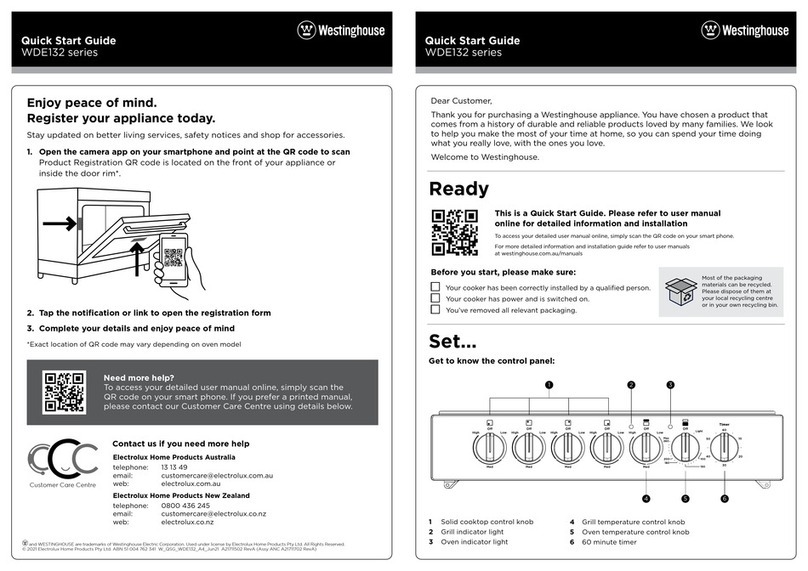
Westinghouse
Westinghouse WDE132 Series quick start guide
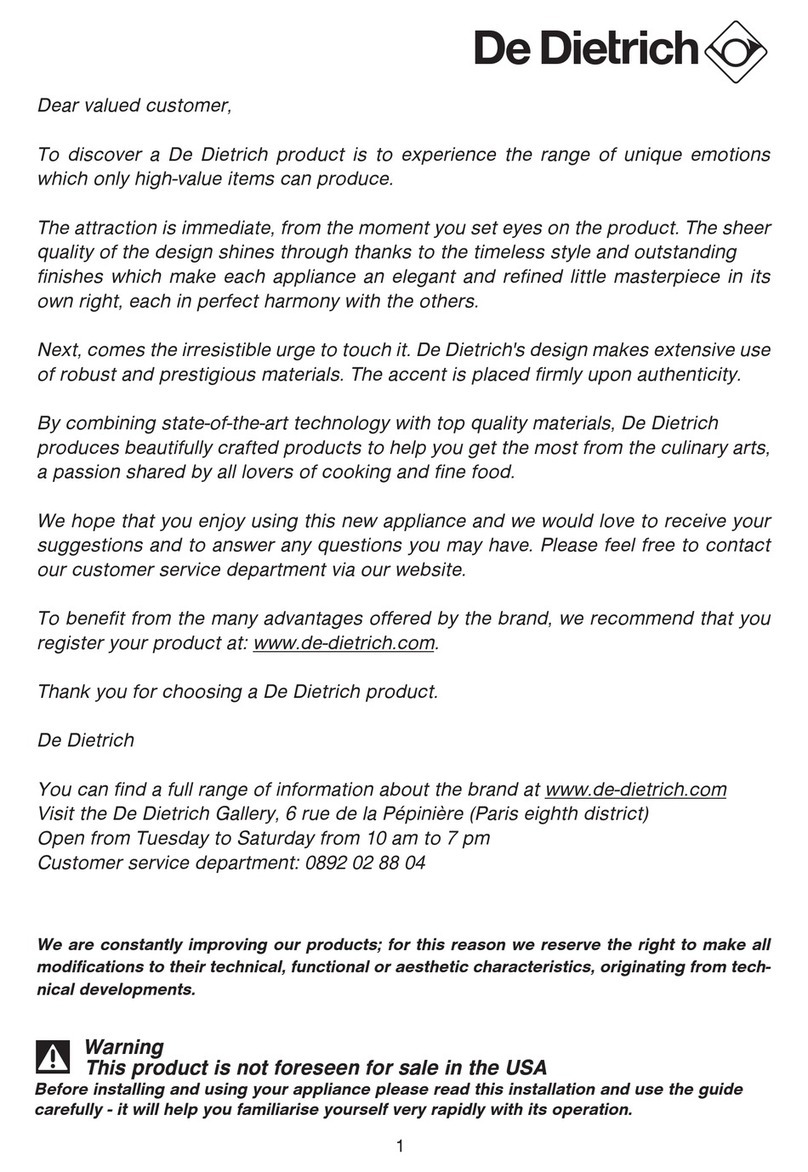
DeDietrich
DeDietrich DTI1106XE user manual

Kenwood
Kenwood CK 230 FS Instructions for use
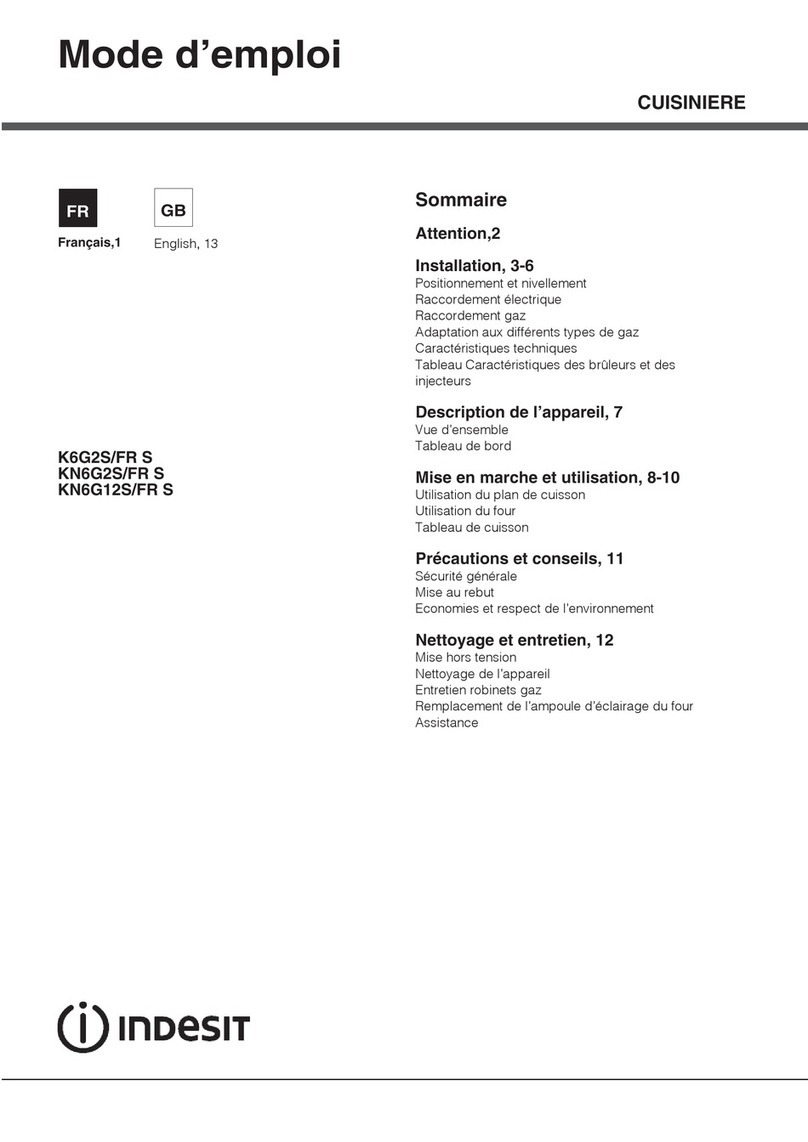
Indesit
Indesit K6G2S/FR S manual

KBS Gastrotechnik
KBS Gastrotechnik 700 Series Instructions for installation, operation and maintenance
